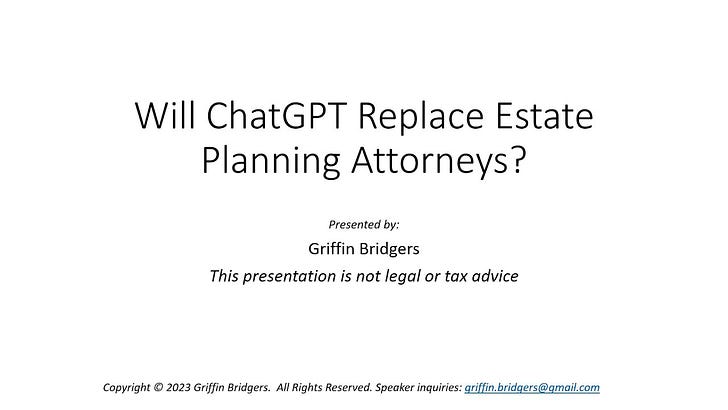Table of Contents
In the last article on AI, we discussed how AI interacts at a high level with an attorney’s duties of competence. My theory is that if you cannot do something without the assistance of AI to begin with, you have no business delegating it to AI. You have a duty to supervise AI output, and to fill in if and when AI fails or does an incomplete job.
Today’s exercise illustrates this principle in real time. If you have basic competence, AI can be extremely powerful. But, as previously discussed, the output is only as good as what you feed AI to begin with. Today’s premise is as follows. Let’s say we have a generic estate planning form, like a pourover will, that is not programmed with a bunch of tags as we might see for an automation platform. Instead of paying for (sometimes expensive) automation or document generation software, could we simply upload the form to AI and then instruct AI to fill in the form based on some notes taken from a meeting with a client?
A couple of years ago, I asked (free) ChatGPT to generate a will - it did not do a good job as seen in the following video. I theorized that this is because there are limited will forms out there in the internet that it was trained on in developing the LLM. But, what if we provided the form? The results are in a second video further below.
Before jumping in however, let’s first explore a discussion on the human side of AI as relates to deep thinking.
Human Side Lesson of the Day
A while back, I cited an article by Michael Kitces on Dunbar’s number - the premise that the human brain can only keep track of (on average) 150 relationships - and how it often limits what one person can manage within a professional services firm.
The deeper message, however, is that there are different tiers of what our brain can do and manage. In some cases, AI is purported to help with some of these “limitations” of our memory, project management and processing power. In reality, however, I believe there are limitations to consider that we might not yet have expressly recognized.
An average attorney’s day is split into tasks we can do on autopilot, versus tasks that require deeper thinking. It is said that AI will allow us to automate the tasks done on autopilot, thus opening up more room for client discussions and for deep thinking. What if, however, we have limited capacity for deep thinking? And, what if we have limited social energy for client meetings?
In other words, let’s say you now have 20 extra hours in a week. Is filling all 20 hours with deep thinking, and/or client meetings, an appropriate way to view attorney productivity? Perhaps to a certain extent, but I don’t believe this can be done on a perfectly correlative basis. Increasing the volume of relationships to be managed by a professional will create diminishing returns, and (even with the assistance of AI) can lead to mistakes and/or burnout. We might not be able to fill all 20 hours, or even a significant portion of that time, with more cognitively-demanding tasks.
I bring this up to say that it is important when determining a firm’s AI strategy to consider the renewed expectations placed upon attorneys. Maintaining similar billable hour or revenue goals, using historical practice standards, may not work when we explore the bounds of what makes us human. We can only spend a finite number of hours per week in deep analysis. Likewise, we can only spend a finite number of hours per week in deep discussions with clients. It may be folly to objectively view the limits of the human brain from an industrial perspective.
In other words, if quality over quantity becomes the possibility driven by AI, how can this be balanced with expectations of increased quantity? It brings us back to the classic adage of, “Good, fast, and cheap… pick two.”
AI Exercise - Populating a Pourover Will Form
To be clear, this was an exercise I did not pre-test. You will hear, in real time, my analysis and (somewhat surprised) reaction to a situation where I used Claude AI to:
Upload a pourover will form, with generic placeholders, blanks, and simple alternatives in the form language (married versus unmarried for example);
Type in some generic hypothetical form choices in a memo such as client name, children’s names and birthdates, pourover trust name, names of fiduciaries, and even the address at which the will would be executed; and
Ask Claude, based on the information provided in the memo, to edit the form I uploaded.
Here are the results:




